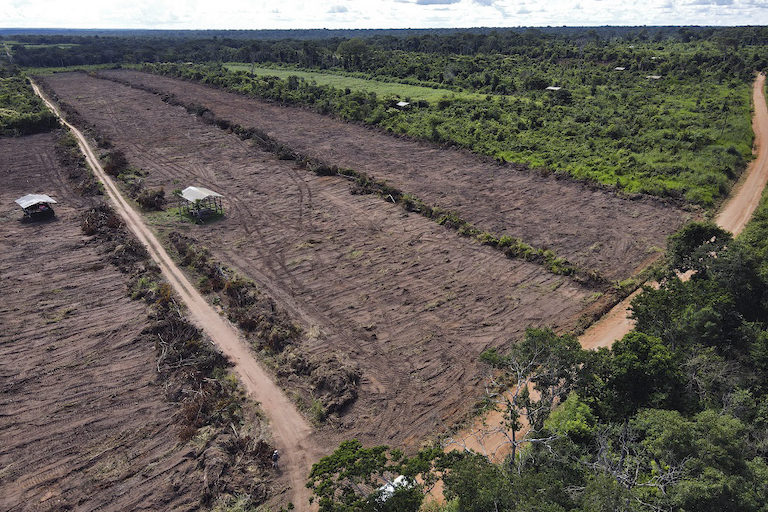

SAN IGNACIO DE VELASCO, Bolivia — On Feb. 12, 2021, Bolivian conservationists joyfully celebrated the creation of the Bajo Paraguá Municipal Protected Area. Located in the municipality of San Ignacio de Velasco in the Bolivian department of Santa Cruz, the new reserve was established to protect 983,006 hectares (2.4 million acres) of Amazonian and Chiquitano forest.
The news was celebrated internationally. U.S. actor and environmental activist Leonardo DiCaprio who wrote on his Instagram account: “This is encouraging news for the wealth of wildlife these areas support, and also for the Chiquitano and Guarasugwe Indigenous groups that live within the areas and depend on the forests for their livelihoods.”
But the celebrations were short-lived. Just a few days after Bajo Paraguá was established, reports of continuing deforestation and colonization inside the new protected area began filtering to regional authorities. Local sources said that what was once lush forest filled only with the sounds of wildlife was suddenly overpowered by the noise of tractors and chainsaws as trees began to fall.
One man, Miguel Ángel*, who lives near Bajo Paraguá, claims he was one of these invaders. On a warm, windy day in May, Ángel settled under the shade of a mango tree next to a lake near the San Ignacio de Velasco dam to speak to Mongabay reporters about how land trafficking mafias operate. He agreed to the interview on condition of anonymity out of fear for his safety.
One man, Miguel Ángel*, who lives near Bajo Paraguá, claims he was one of these invaders. On a warm, windy day in May, Ángel settled under the shade of a mango tree next to a lake near the San Ignacio de Velasco dam to speak to Mongabay reporters about how land trafficking mafias operate. He agreed to the interview on condition of anonymity out of fear for his safety.
Allegations of corruption
Land trafficking isn’t just a problem in the Chiquitania region. A publication published by the Tierra Foundation in April 2021 found that land trafficking has been intensifying in Bolivia since 2011. It also alleges the “INRA paralelo” – a group comprised of former civil servants and public officials – engaged in falsifying agricultural documents and “laundering” legal records to sell land to the highest bidder.
According to the Tierra Foundation, the INRA authorized more than 1,400 new communities to settle in the department of Santa Cruz between 2014 and 2019. But the foundation claims that many of these territories are “ghost communities” that are in the hands of land traffickers.
In November 2020, Tierra Foundation reported that 33,480 hectares (82,730 acres) in the department of Santa Cruz were irregularly granted to former Minister of Economy Branko Marinkovic, who was appointed during the tenure of interim President Jeanine Añez. On Aug. 4, 2021, during the administration of current President Luis Arce, the INRA announced the reversion of 26,000 hectares of that allotment, indicating that they had been illegally titled.
An analysis by nonprofit think tank InSight Crime found that the illegal trade in land titles in Latin America is facilitated through connections with government officials “who can give illicit deals a necessary veneer of legitimacy.”
“This has long been the case in Bolivia,” InSight Crime stated, referring to the arrest on Apr. 14, 2021, of former Rural Development and Land Minister Edwin Characayo for accepting a $20,000 bribe in exchange for acting “in favor of certain people seeking to acquire and clear land for agricultural purposes.” According to the police, that money was an advance payment on a much larger bribe of $380,000.
According to InSight Crime, this situation “brought to light how corrupt schemes related to land trafficking corruption have plagued successive governments, regardless of who is in office.”
Mongabay contacted INRA Santa Cruz departmental director Adalberto Rojas, but did not receive a response.
A vanishing home
Oswaldo Maillard, head of the Chiquitano Dry Forest Observatory of the Chiquitano Forest Conservation Foundation (FCBC), told Mongabay that the deforestation observed in the Bajo Paraguá area has a fishbone pattern. This type of deforestation consists of opening a gap (such as a road) and then clearing the forest on both sides.
Maillard and his colleagues from the FCBC are in charge of monitoring the Chiquitano Dry Forest. He said that “small tin houses began to appear in some areas. An indication that they would start clearing.”
Maillard said land traffickers have cleared approximately 150 hectares (370 acres) of Chiquitano forest in Bajo Paragua. “One could say it’s relatively low, but those are the first signs to continue clearing.”
The deforestation of Bajo Paraguá is just the tip of the iceberg. Zooming out, San Ignacio de Velasco had one of the highest rates of municipal deforestation in Bolivia in 2020. Since last year, 47,197 hectares (116,626 acres) of forest has been lost, half of which was illegally cleared, according to data from FCBC and the Forests and Lands Authority.
In 2020 Bolivia jumped up to third place in terms of primary forest loss, losing 276,883 hectares (684,192 acres) of primary forest, according to data from the University of Maryland visualized on Global Forest Watch.
Herman Vaca Poñé, a forest engineer who helped create Bajo Paraguá Municipal Protected Area, said that the reserve is a key wildlife corridor that connects to Noel Kempff Mercado National Park, one of the best-preserved parks in the Amazon Basin and a UNESCO World Heritage Site. He said conversion of Bajo Paraguá’s forestland to crop fields is a shortsighted endeavor.
“Bajo Paraguá is an area destined for forest production,” Vaca Poñé said. “If you change that land use to agriculture, you will probably have five to six years of production, and then the yield will drop, and the soil will compact.”
In his recent book, “A Perfect Storm in the Amazon Wilderness,” published by White Horse Press, researcher Tim Killeen writes that Indigenous people are the strongest and most effective defenders of the Amazon because the fight for their territories is existential: “If they lose their land, they will lose their identity and will cease to exist as a people. They know it because they survived a holocaust.”
What Killeen expressed in his book is reflected in the tears that ran down the face of Lorenza Poicheé, an Indigenous Chiquitana woman who spoke to Mongabay about deforestation in San Ignacio de Velasco in May 2021. “It hurts that we can no longer teach our children what our parents taught us.”
Arminda Gómez from the Indigenous community of San José de Campamento, near Bajo Paraguá, urged other Indigenous residents to remain a united front against land traffickers.
“If we don’t protect our culture, they will take it from us,” Gómez said, “and if we don’t make an effort to stay united as a Chiquitana culture, we’ll be in trouble.”
Source
Language of the news reported
Related content:
Copyright © Source (mentioned above). All rights reserved. The Land Portal distributes materials without the copyright owner’s permission based on the “fair use” doctrine of copyright, meaning that we post news articles for non-commercial, informative purposes. If you are the owner of the article or report and would like it to be removed, please contact us at hello@landportal.info and we will remove the posting immediately.
Various news items related to land governance are posted on the Land Portal every day by the Land Portal users, from various sources, such as news organizations and other institutions and individuals, representing a diversity of positions on every topic. The copyright lies with the source of the article; the Land Portal Foundation does not have the legal right to edit or correct the article, nor does the Foundation endorse its content. To make corrections or ask for permission to republish or other authorized use of this material, please contact the copyright holder.


